editorial pick - Community: The Structure of Belonging
by Peter Block
Berrett-Koehler Publishers, Inc 200

“The essential challenge,” writes Peter Block in his introduction, “is to transform isolation and self-interest within our communities into connectedness and caring for the whole.” It is not enough to assume individual transformation will lead to collective change, so Block explores the nature of collective transformation and offers us concrete ways to move forward.
The real gem of this book is its focus on deeply meaningful and life-affirming ways both of working and being together in the difficult questions. Our questions, he says, are more transforming than answers. The leaders we need are already among us. Our leadership practice is to create the spaces, context and conversations that we, collectively, need to be in.
What I appreciate about Peter Block’s body of work, and this book is no exception, is how he illuminates what we already know with language and processes that are inspiring and practical. He makes it real: we need to connect, so let’s build a social fabric and architecture infused with the spirit of people acting together in true citizenship, as communities, based on our assets and gifts and not our fears or problems. This is the structure of belonging. Do this well — and yes, it is hard — but this IS the work.
— vanessa reid
back to top
editorial pick - Enlighten Up! A Skeptic’s Journey into the World of Yoga
Directed by Kate Churchill
Tuka Productions 2008

Kate Churchill sets out to prove that “yoga can transform anyone.” Her subject: 29-year-old journalist Nick Rosen from New York City. With a shamanic healer mother and corporate lawyer father, Nick has a balanced sense of skepticism and curiosity, and he seems prepared to spend six months of his life in a search for “enlightenment.”
Their quest begins in the crowded yoga studios of NYC and takes Nick, Kate (whose role as “director” and antagonist is transparent throughout the film) and the whole film crew to Los Angeles, Hawaii and, finally, India. They encounter celebrity yoga teachers, a former pro wrestler, Pattabhi Jois’ first American disciple, Norman Allen, and a whole lot of saddhus. Candid conversations with B.K.S. Iyengar, Dharma Mitra and Sharon Gannon and David Life shed wisdom and light on their journey.
Intelligently edited with wit and humour, Enlighten Up! presents yoga in all its complexities, and points out the sincerity and absurdity of the practice in the context of the modern world. Nick resists “transformation,” despite (or perhaps, because of) persistence from Kate. At the end, he deems the experiment a “failure.”
Yet he also admits that he felt some effects from the months of intensive daily yoga practice. It’s apparent in the movie, as well, when he has some insights into his family and life. And this, I feel, is the true transformation, true enlightenment, and indication of the power of yoga: it is subtle, slow and unexpected.
— roseanne harvey
back to top
editorial pick - Get It Ripe: A Fresh Take on Vegan Cooking and Living
by Jae Steele
Arsenal Pulp Press 2008
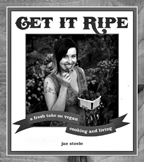
I’m neither a vegan nor a baker, but I have made Jae Steele’s Carob Chai Cake for many a dinner party and it’s always a hit. There is something about her accessible writing style and clear recipe ingredients that can make even the clumsiest non-vegan person feel like a culinary goddess.
Jae has been writing adorable little “cookzines” for years, and this book is her first full-length collection of recipes, many of them gems from her zines and blog. A holistic nutritionist based in Montréal and Toronto, Jae knows her stuff — the first third of the book is chockfull of information on food choices, a “manifesto for a vegan whole foods diet” and the details of digestion, as well as the basics of stocking a kitchen and preparing food.
While the book is intended to be a primer for anyone new to veganism or a resource for long-time vegans, Jae also acknowledges that “the book is also here to help uncover both the delectable goodness and health benefits of choosing foods that the earth naturally provides us.” Jae offers her expertise, wisdom and passion to serve the growing whole foods and vegan movement.
roseanne harvey
back to top
The Secret Power of Yoga: A Woman’s Guide to the Heart and Spirit of the Yoga Sutras
by Nischala Joy Devi
Three Rivers Press 2007
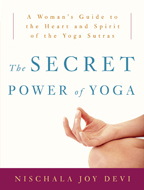
My first introduction to Nischala Joy Devi was at a yoga conference in Toronto. With humour in her voice, she suggested that so many more women than men do yoga in North America because (a) they’re more highly evolved, or (b) they recognize what yoga has to offer.
It’s the (b)-line of thinking that she follows more deeply and reverently in her new book, The Secret Power of Yoga: A Woman’s Guide to the Heart and Spirit of the Yoga Sutras, inviting readers into the depth and mystery of Patanjali’s Yoga Sutras from an intentionally feminine perspective.
Devi’s translation of and commentary on the yoga sutras comes in response to many requests from female students asking her to recommend a translation they could relate to. She’s not a Sanskrit scholar, but Devi has worked with several English translations to create a “heart-centred” composite of each sutra. Her commentary is interwoven with repetitions of the sutras within the text. The book is written with the intention of restoring the value of feeling and intuition — long associated with the domain of the feminine — to the sutras, and in turn to the collective experience of being human.
Although I find some of the sutras themselves a little dry, Devi has a very light touch and the contemporary parables she sketches in her commentary make clear how practically the wisdom of the sutras can be applied to life. In a passage relating to Kriya Yoga (yoga in action), she writes that the opportunity to practise tapas (burning away unhelpful habits of the mind) is limitlessly available. For instance, if someone steals your parking spot, can you avoid projecting frustration onto yourself or those around you? “How we react to these situations becomes the framework for our spiritual practice,” Devi writes. “The supreme purpose of Tapas is to accept life’s challenges while being loving and compassionate to all, especially ourselves.”
Throughout the book, Devi avoids the negative language that has been sewn into the sutras through various English translations over the decades. In the passages relating to the yamas, ahimsa (often translated as non-violence) becomes “reverence, love, compassion for all”; astheya (typically non-stealing) becomes “abiding in generosity and honesty”; and aparigraha (non-grasping) becomes “awareness of abundance, fulfillment.” Her commentary also retells and reinterprets old myths, helping women to see themselves in light of ancient teachings whose purpose is to guide us toward greater understanding.
The subtle thrust of the book is to bring about balance and union of masculine and feminine by restoring the feminine to its rightful place of importance in the sutras — and in our daily practices of living. Devi gives exercises to attune readers to different levels of meaning within the sutras, and layers of thinking to be contemplated over time. In the time that I have been working with the book, I have felt a subtle discovery of a new perspective on life’s inevitable challenges. The Secret Power of Yoga inspires a renewed acceptance of the feminine aspects of my own personality that I’ve found empowering. \
— Kendra Ward
back to top
Double Lives: Writing and Motherhood
eds. Shannon Cowan, Fiona Timwei Lam and Cathy Stonehouse
McGill–Queens University Press 2008
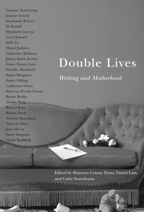
A few months ago I was finishing the draft of my novel, working on several freelance writing projects and navigating my two sons through spring cold and flu season, when a friend handed me a copy of a new compilation of essays entitled Doubles Lives: Writing and Motherhood.
I found myself flipping through its pages at every available moment, hoping to learn from the experiences of other mothers who write.
The harrowing tales of the duality of these two assignments, expressed time and again in these essays by 25 emerging and established Canadian writers, including Marni Jackson, Susan Musgrave and Janice Kulyk Keefer, made it clear that to be a writer and a mother is not an easy task. A writer needs space and quiet to allow ideas to form and then solitary time to flow words out on the page. A mother is always on call, always available, always ready to be interrupted.
Double Lives offers more than many touching and often humorous silhouettes of the everyday lives of mothers who write. It offers a compelling forum for discussing the many societal and cultural threads that form the backdrop from which writing mothers express themselves. “Could I be a poet, a writer and a mother at the same time?” asks
Di Brandt. She found that “poetry and mothering seemed inextricably linked,” but that the many demands on mothers in our culture made the experience fraught. In the stolen moments that these mother/writers found to, as Janice Kulyk Keefer calls it, “scratch a few words across the silence in which the rest of the house is sunk,” they have brought to vivid life the “behind the pages” experience of women writers in Canada.
There are moments of aching beauty in each essay, but after staying up late the first night reading Double Lives, I slowed down and took in smaller chunks at a time. This was not just to ward off sleep deprivation, which is clearly an occupational hazard among mothers who write. I found that the litany, the recitation of the familiar daily struggles became overwhelming. It was jarring to leave the poetic narrative and fall into the “trivia and mundane anxieties” that fill every mother’s mind. But that’s what it’s like for the writer as well, interrupted from the flow of words to deal with the more immediate demands of household and children.
I kept returning to the words of those writers who, as grandmothers, seem to have found a union in their two callings. “This is how mothering and creativity and writing have come to mean very much the same thing for me, how they are intricately woven together in my life, now,” writes Di Brandt. I was left feeling hopeful that by sharing their words, writing mothers are not engaged in a selfish act, but a gift to their children and the world. An inspiring thought, and one that, along with a good strong cup of coffee, helps to propel me to my writing desk every morning at four, to scratch out a few words before my children wake up. \
— Deryn Collier
back to top
Victrola Favorites: Artifacts from Bygone Days
various artists
Dust-to-Digital 2007
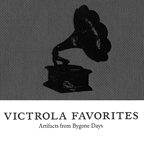
Victrola Favorites was originally released as a mixtape on cassette with a Xerox insert. The recordings all sound old and slightly scratchy, very much “dust to digital,” but the juxtaposition of styles and cultures is equally lively and refreshing. The universal spirituality of sound provides the true connective grid for both compilations, so that the chanting of a group of “Chinese Buddhist Nuns” and the debauched noises of a “Seven Gallon Jug Band” seem to resonate with each other, and somehow even speak of similar things.
The original intentions of those recorded are lost, as is any sense of geographical context, despite the loving documentation of the various acts, but instead the listener is left with a heightened sense of a particular moment in history, and a particular technology, the 78 rpm record, as it manifests in different places around the world. Beyond that, the delightful confusion of styles, cultures and genres on these disks points to the more original and obscure gift of sound itself, and raises the perhaps unanswerable question: where does sound come from? \
— Marcus Boon
back to top
Black Mirror: Reflections in Global Music
various artists
Dust-to-Digital 2007
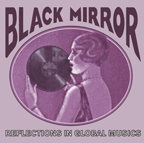
The idea of making a gift, a work of art, out of the work of others goes against many of our most cherished ideas about originality, property and work. But since the Dadaists made paintings out of cut-up clips of newspapers at the beginning of the twentieth century, this kind of art has grown in importance through to today.
With the cut-and-paste capabilities of computers, the edits and sequences of electronic dance music, the rise of the dj, the mixtape, and the iPod playlist, it feels like a basic part of how we live. Peer-to-peer networks proliferate on the internet and mp3 blogs make it possible to exchange music around the world, but the laws against copying and sharing the work of others are also becoming stricter.
Is the free exchange and discovery of the world of recorded sound a service provided as a gift, an education in beauty and possibility? Or is it merely the theft of the work of others, often without even crediting the originals or paying them?
An interesting case in point is two recent compilations on Atlanta’s Dust-to-Digital label: Black Mirror and Victrola Favorites. Both are an offering from obsessive collectors of 78 rpm records, essentially useless objects today since hardly anyone has the equipment to play these disks. The “black mirror” in the title of journalist/musician Ian Nagoski’s compilation is the stone, shellac and carbon surface of these 78 rpm disks, which were produced between the two World Wars. The “Victrola” of Rob Mills and Jeffrey Taylor’s Victrola Favorites was a popular type of record player that played these disks manufactured in the early decades of the twentieth century.
The compilations explore music from around the world, putting together startling juxtapositions of musical styles that appear both random and incredibly appropriate. On Black Mirror, a lovely bagpipe track by Scots Guardsman Henry Forsyth from the 1930s morphs into a South Indian nagasvaram track into a West African rhumba from the 1950s into a Polish gypsy wedding music track. The listener is forced to confront the mix as a series of human sounds, discovered by Nagoski within a thirty-minute drive from his hometown of Baltimore, and costing a total of $125.
back to top